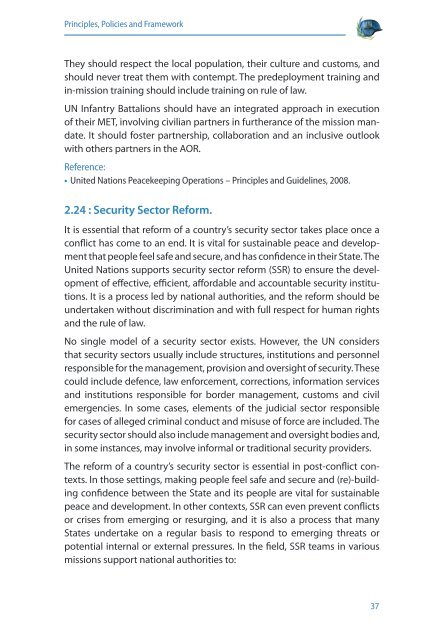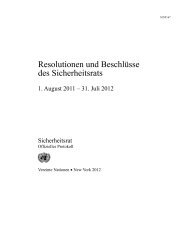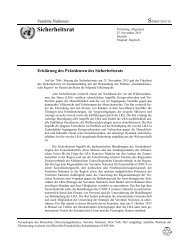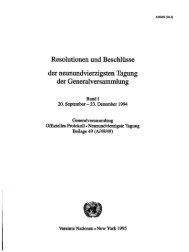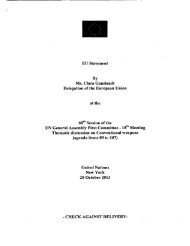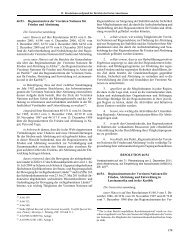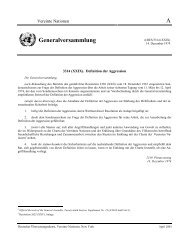United Nations Infantry Battalion Manual - the United Nations
United Nations Infantry Battalion Manual - the United Nations
United Nations Infantry Battalion Manual - the United Nations
You also want an ePaper? Increase the reach of your titles
YUMPU automatically turns print PDFs into web optimized ePapers that Google loves.
principles, policies and framework<br />
They should respect <strong>the</strong> local population, <strong>the</strong>ir culture and customs, and<br />
should never treat <strong>the</strong>m with contempt. The predeployment training and<br />
in-mission training should include training on rule of law.<br />
UN <strong>Infantry</strong> <strong>Battalion</strong>s should have an integrated approach in execution<br />
of <strong>the</strong>ir MET, involving civilian partners in fur<strong>the</strong>rance of <strong>the</strong> mission mandate.<br />
It should foster partnership, collaboration and an inclusive outlook<br />
with o<strong>the</strong>rs partners in <strong>the</strong> AOR.<br />
reference:<br />
• united nations peacekeeping operations – principles and guidelines, 2008.<br />
2.24 : Security Sector Reform.<br />
It is essential that reform of a country’s security sector takes place once a<br />
conflict has come to an end. It is vital for sustainable peace and development<br />
that people feel safe and secure, and has confidence in <strong>the</strong>ir State. The<br />
<strong>United</strong> <strong>Nations</strong> supports security sector reform (SSR) to ensure <strong>the</strong> development<br />
of effective, efficient, affordable and accountable security institutions.<br />
It is a process led by national authorities, and <strong>the</strong> reform should be<br />
undertaken without discrimination and with full respect for human rights<br />
and <strong>the</strong> rule of law.<br />
No single model of a security sector exists. However, <strong>the</strong> UN considers<br />
that security sectors usually include structures, institutions and personnel<br />
responsible for <strong>the</strong> management, provision and oversight of security. These<br />
could include defence, law enforcement, corrections, information services<br />
and institutions responsible for border management, customs and civil<br />
emergencies. In some cases, elements of <strong>the</strong> judicial sector responsible<br />
for cases of alleged criminal conduct and misuse of force are included. The<br />
security sector should also include management and oversight bodies and,<br />
in some instances, may involve informal or traditional security providers.<br />
The reform of a country’s security sector is essential in post-conflict contexts.<br />
In those settings, making people feel safe and secure and (re)-building<br />
confidence between <strong>the</strong> State and its people are vital for sustainable<br />
peace and development. In o<strong>the</strong>r contexts, SSR can even prevent conflicts<br />
or crises from emerging or resurging, and it is also a process that many<br />
States undertake on a regular basis to respond to emerging threats or<br />
potential internal or external pressures. In <strong>the</strong> field, SSR teams in various<br />
missions support national authorities to:<br />
37


